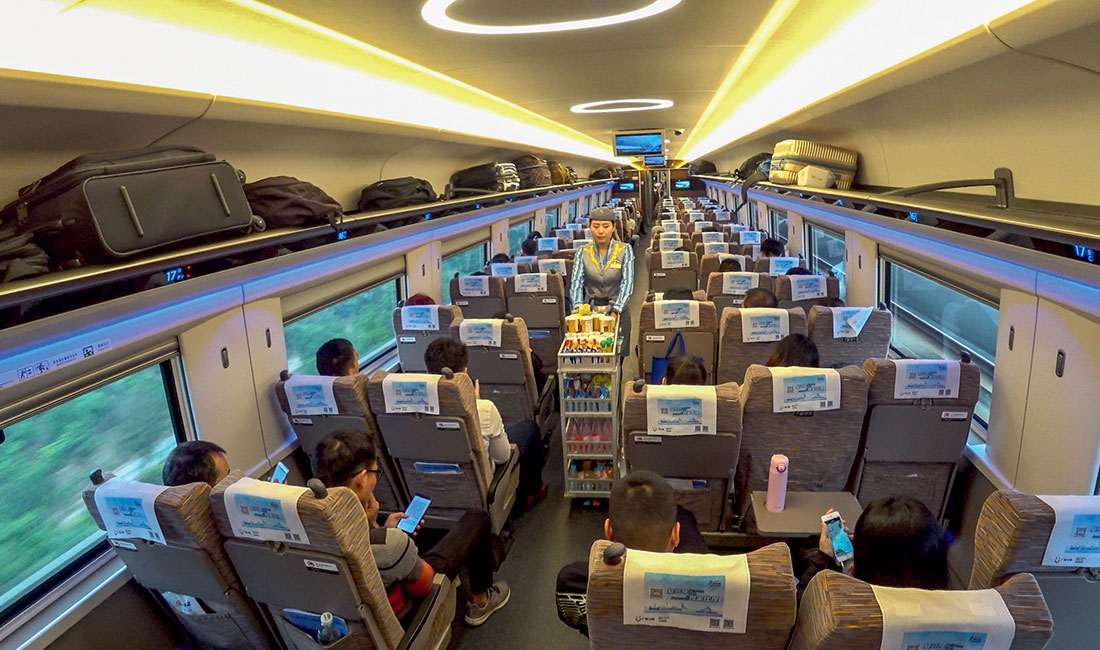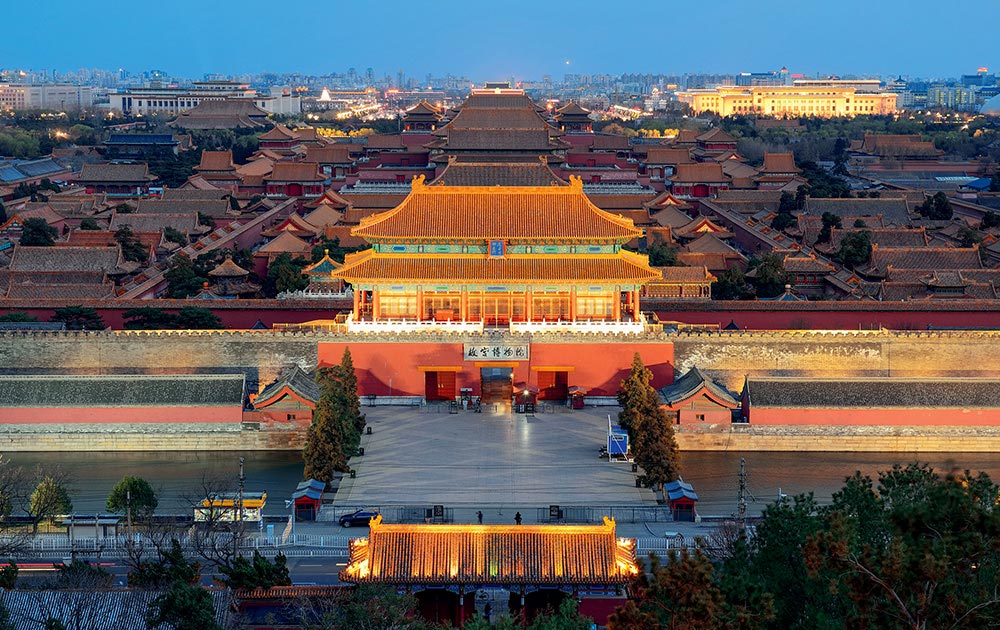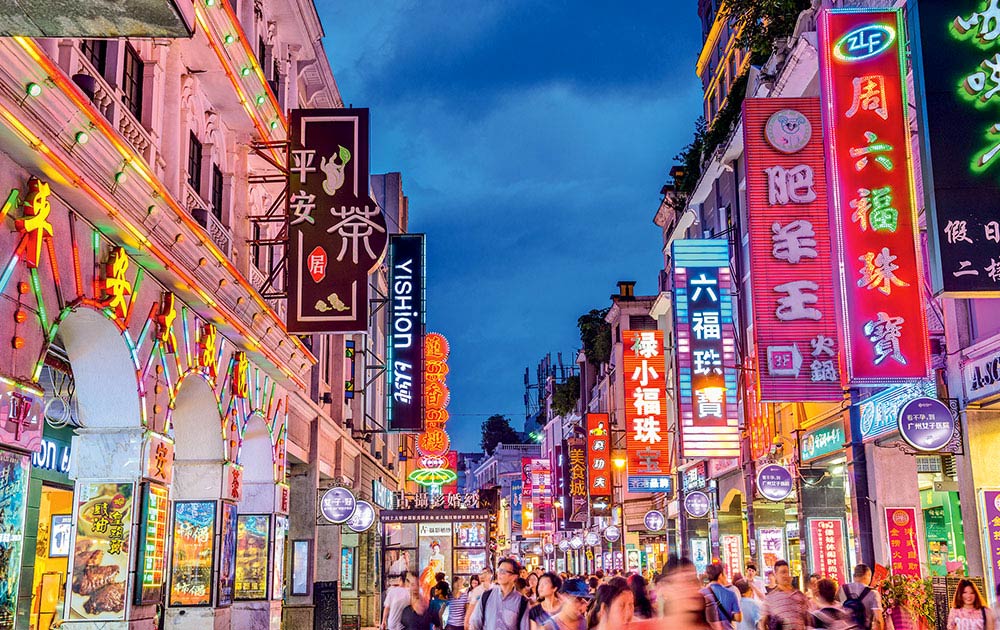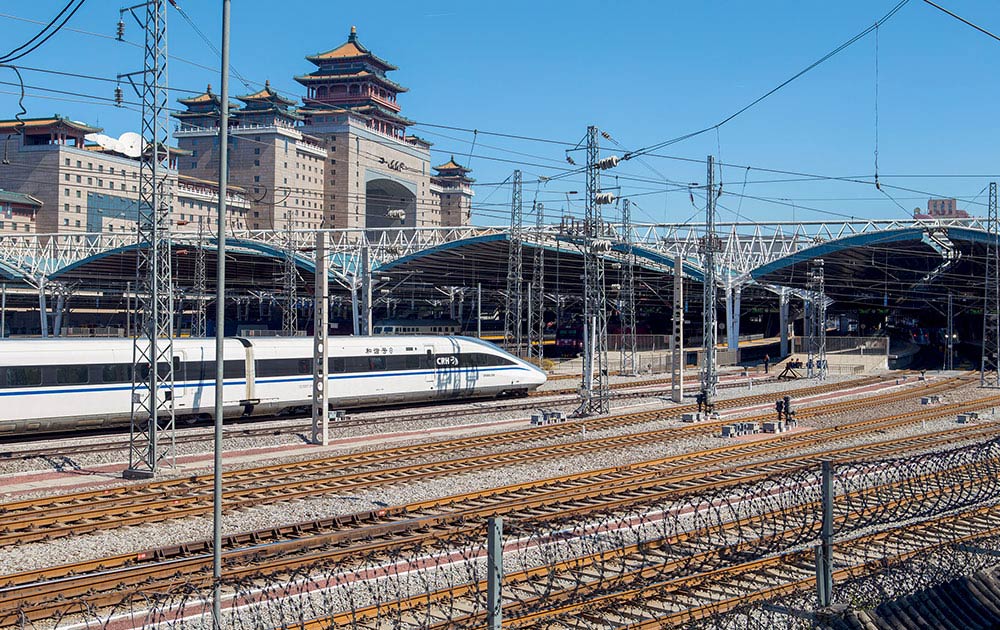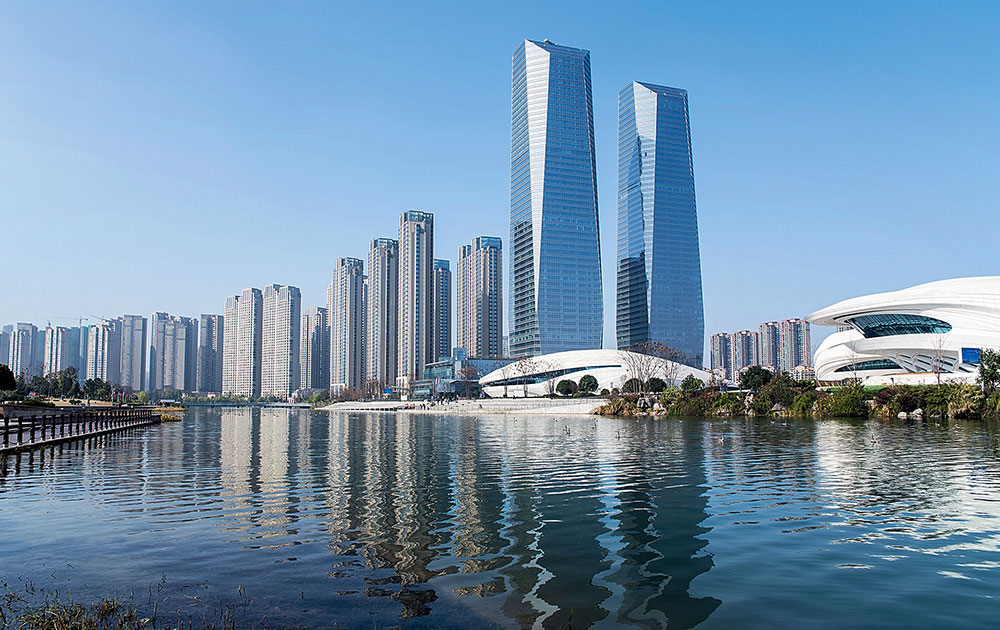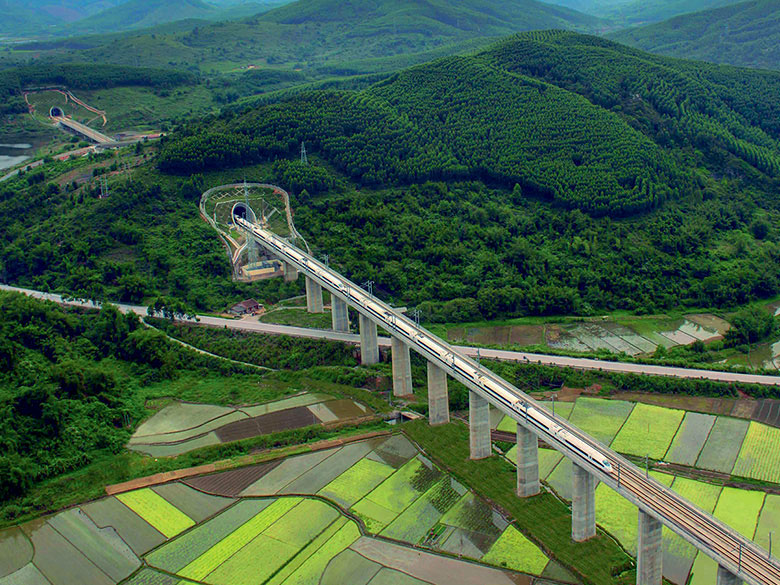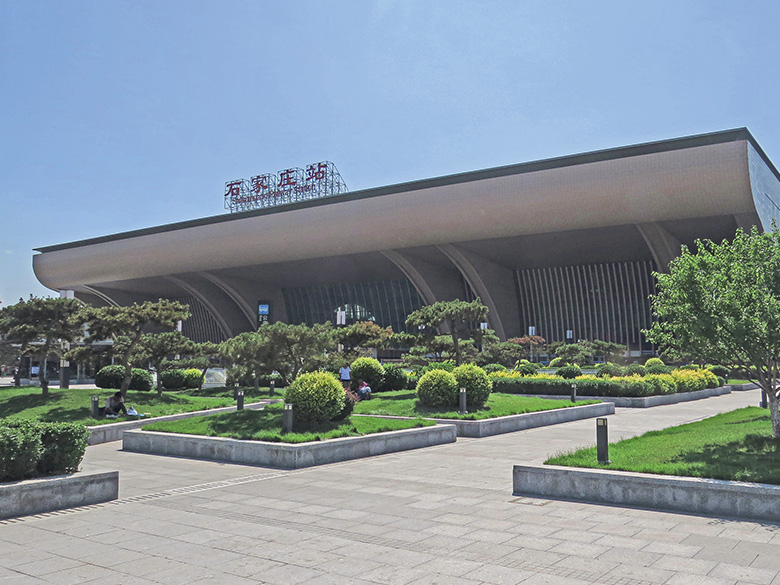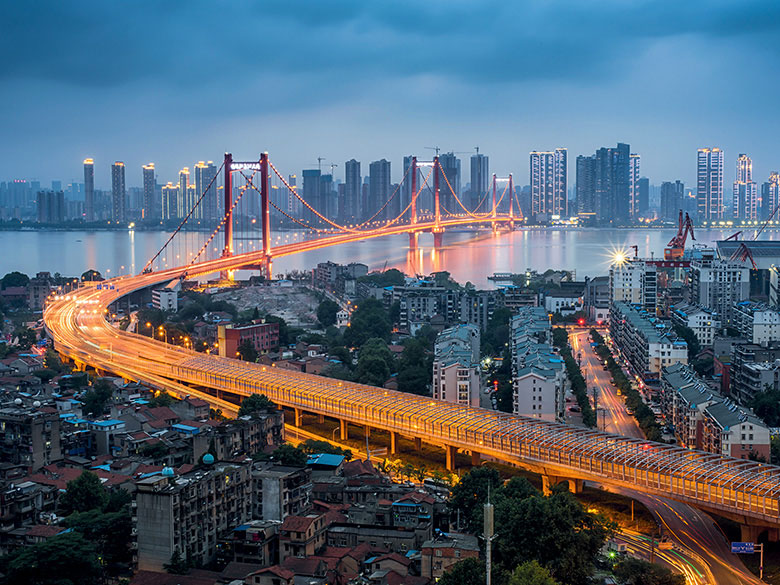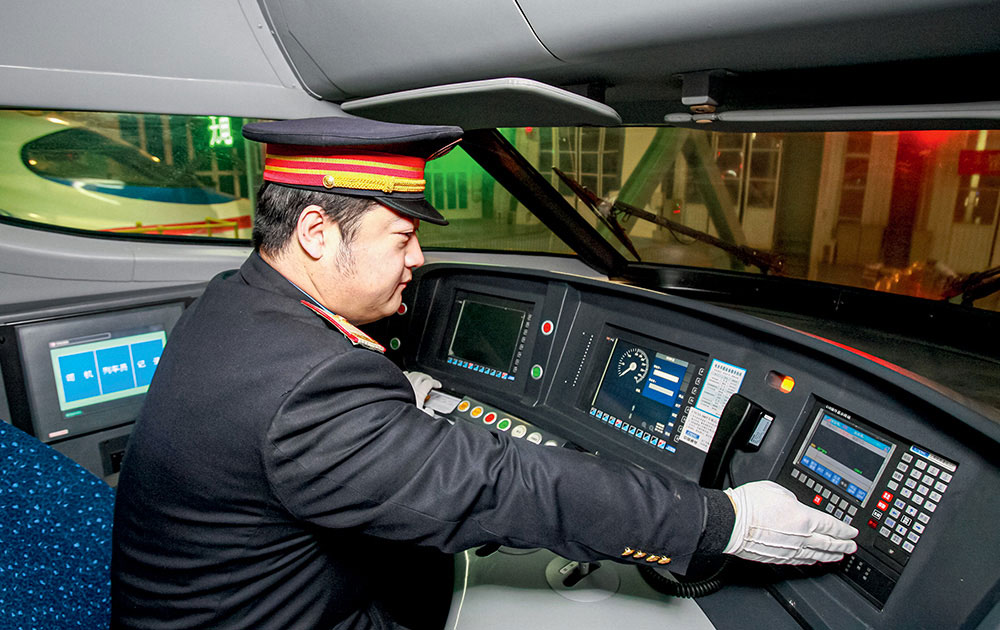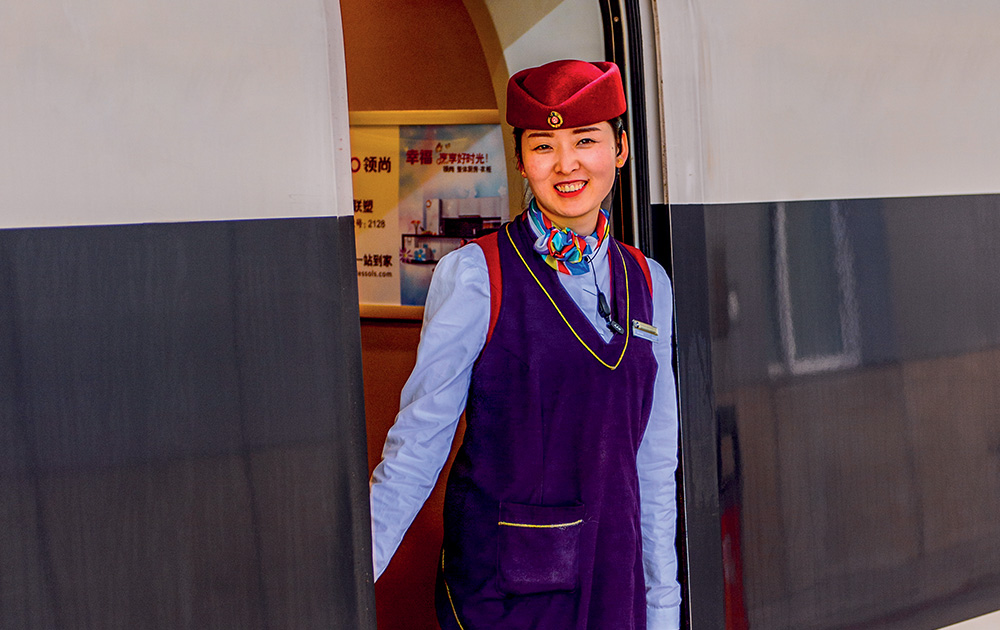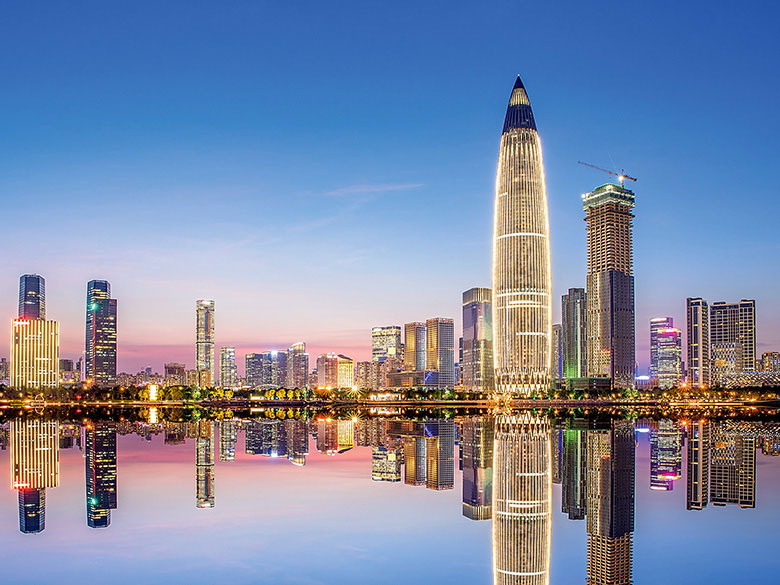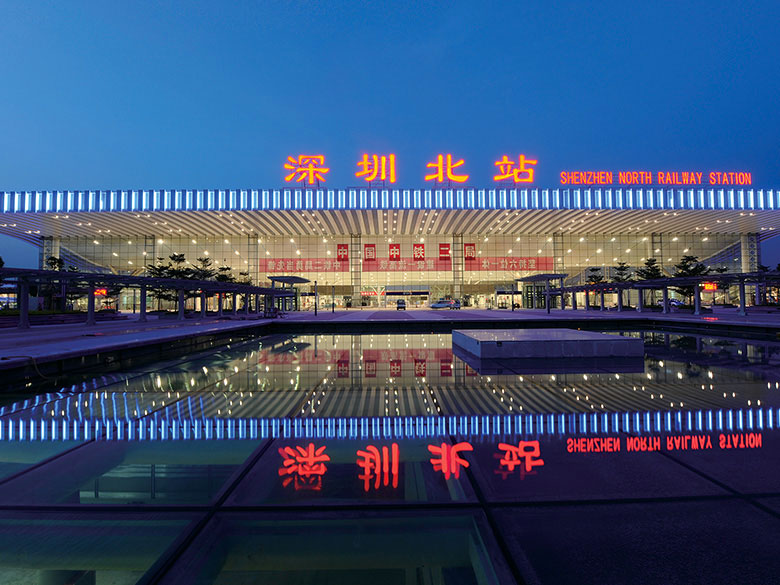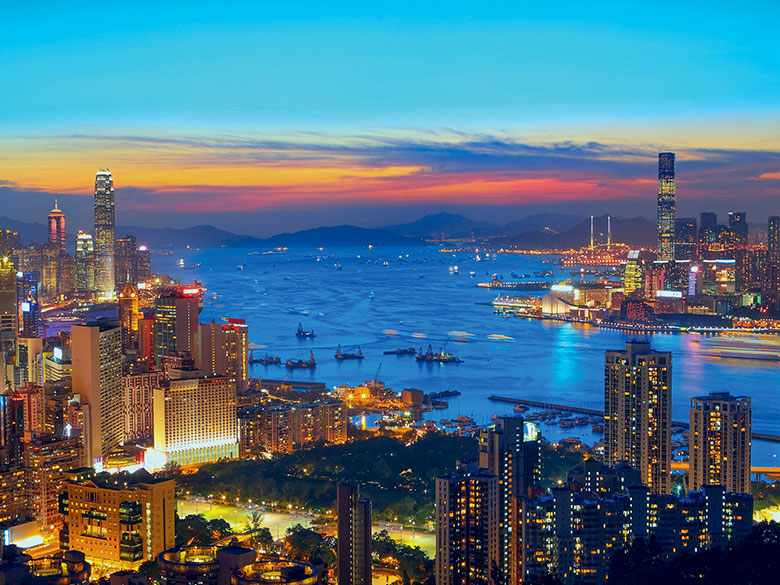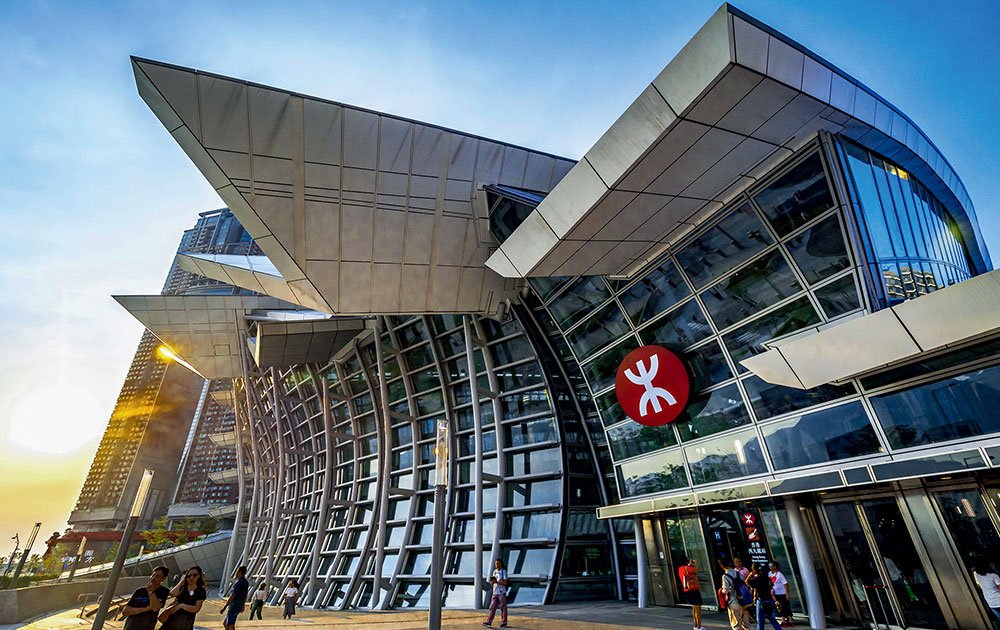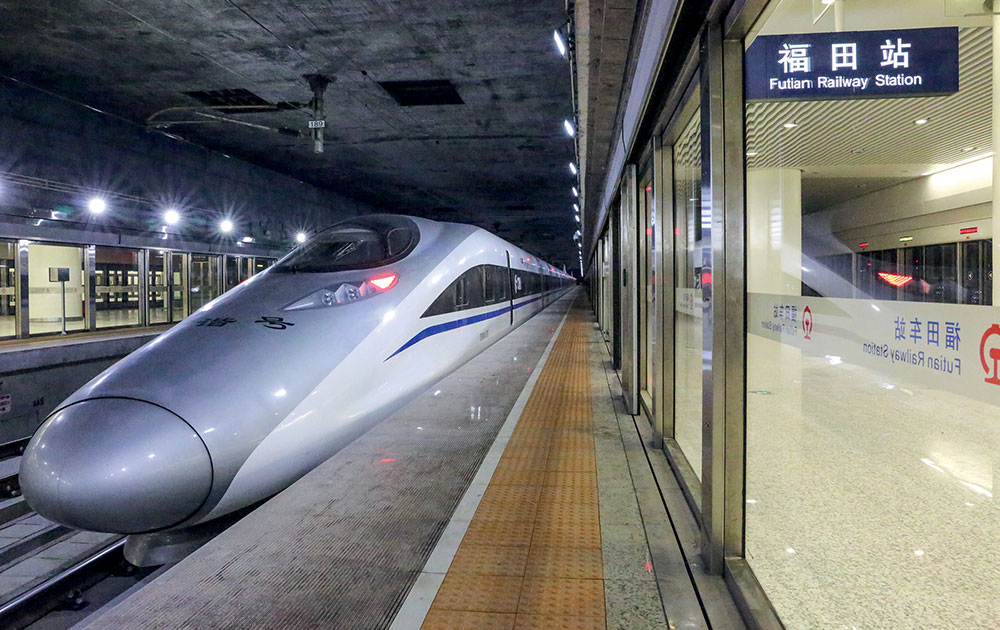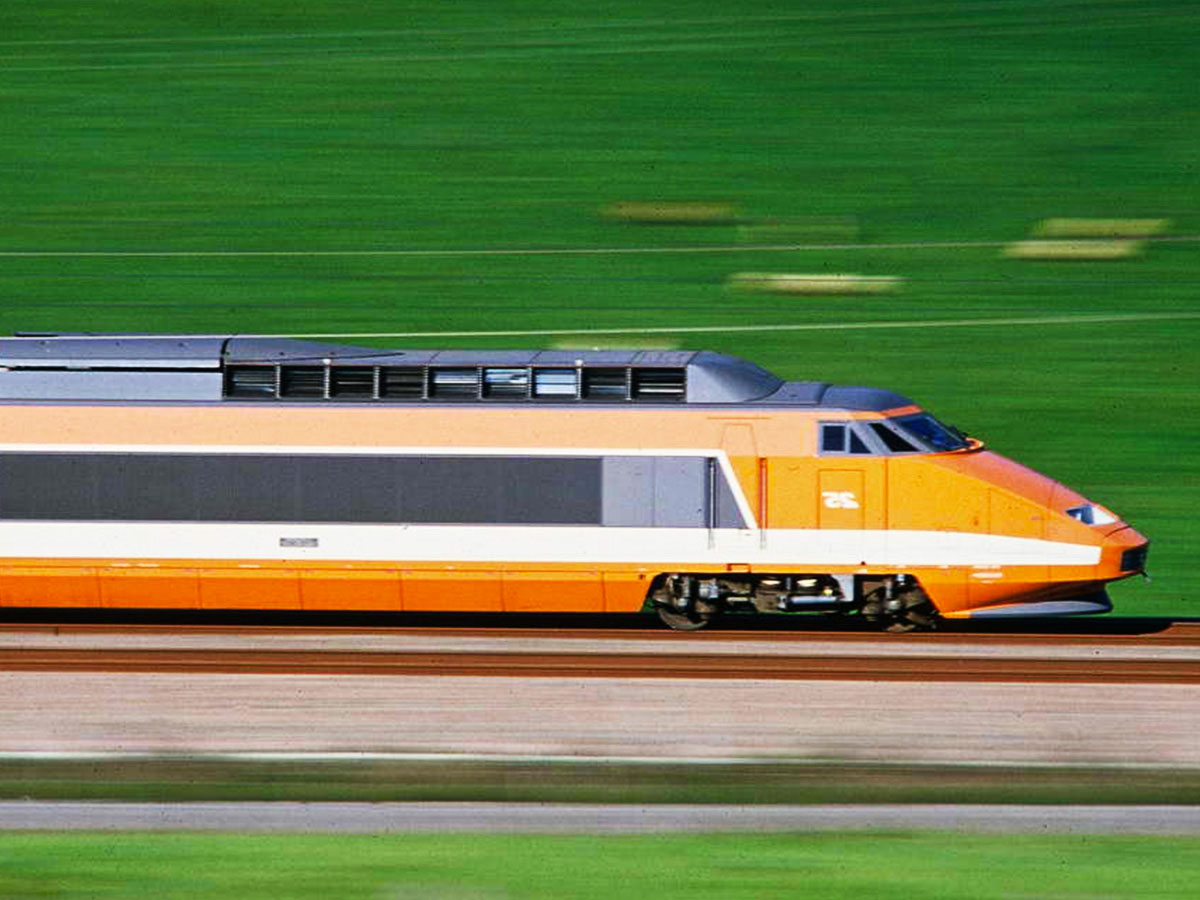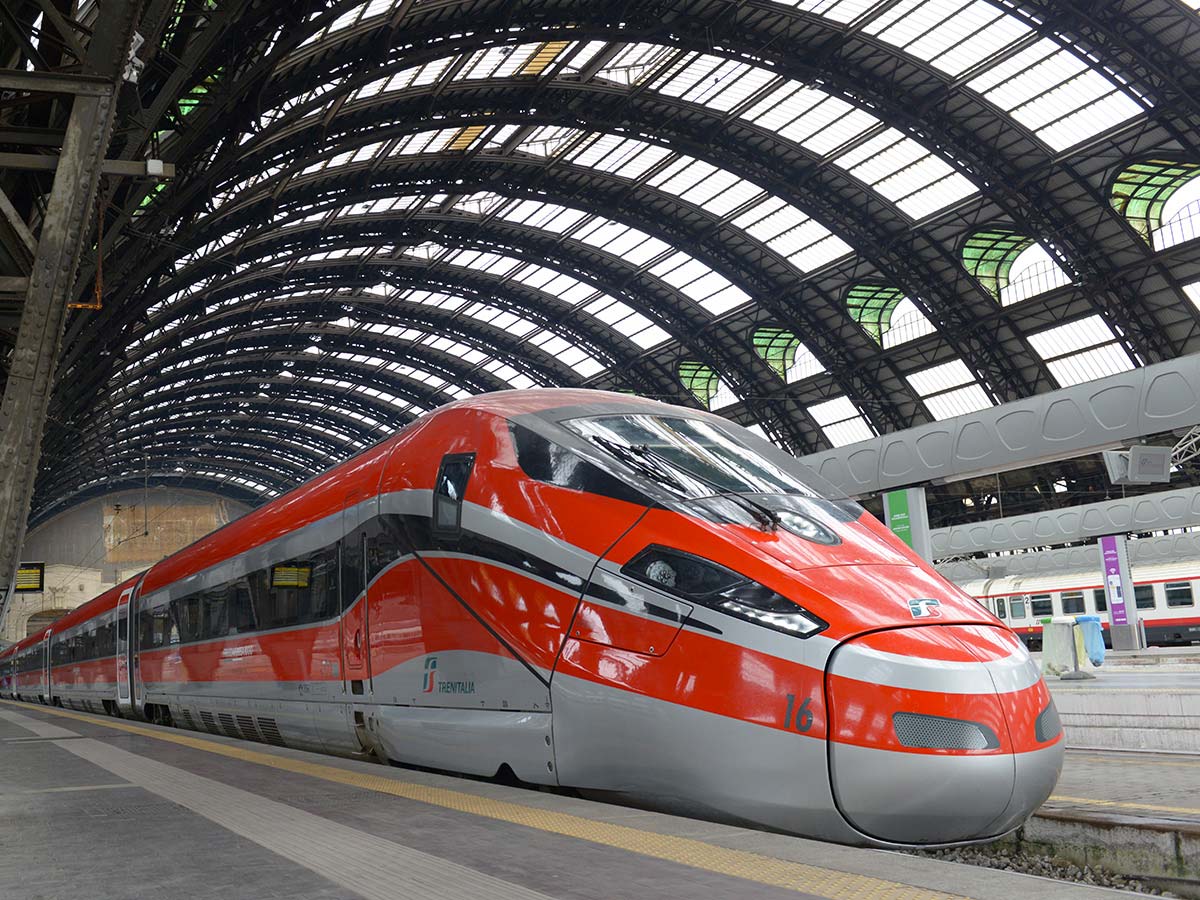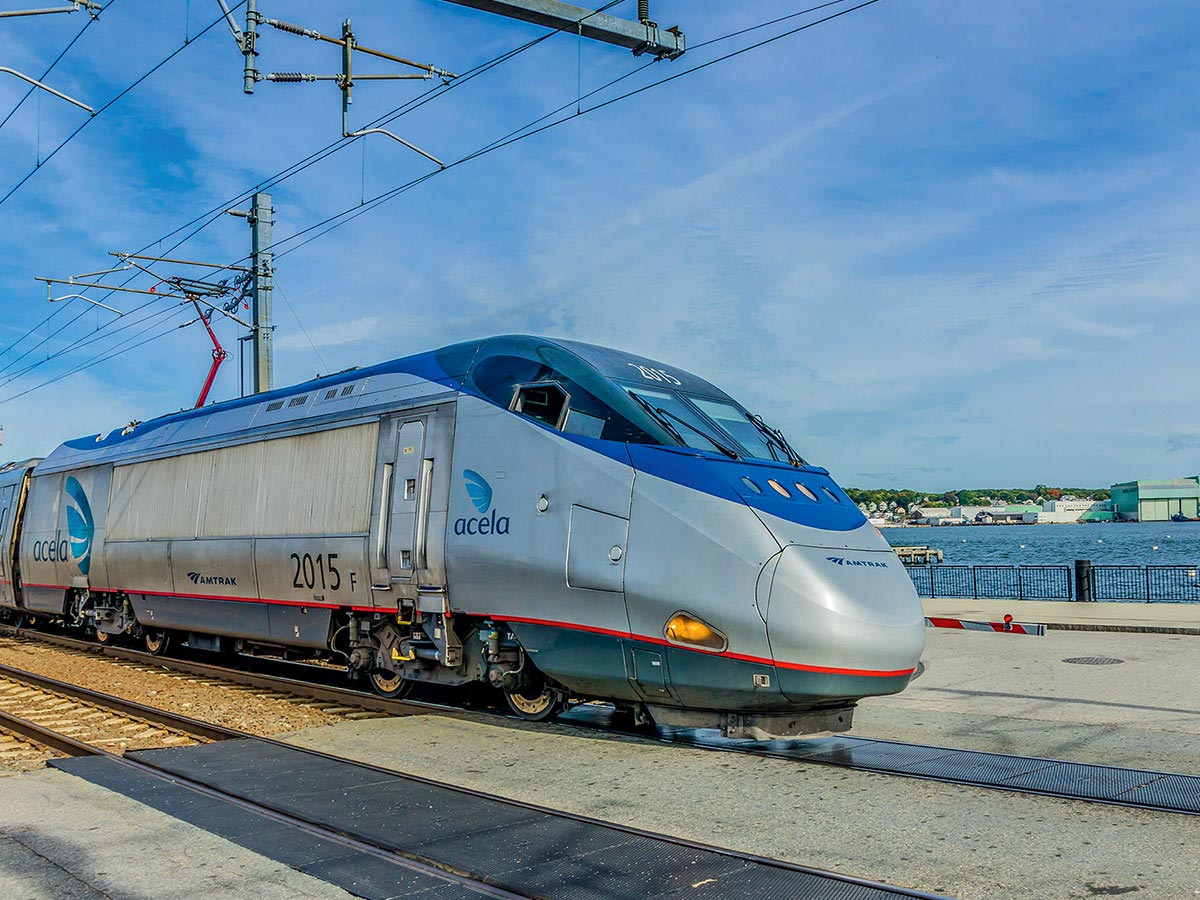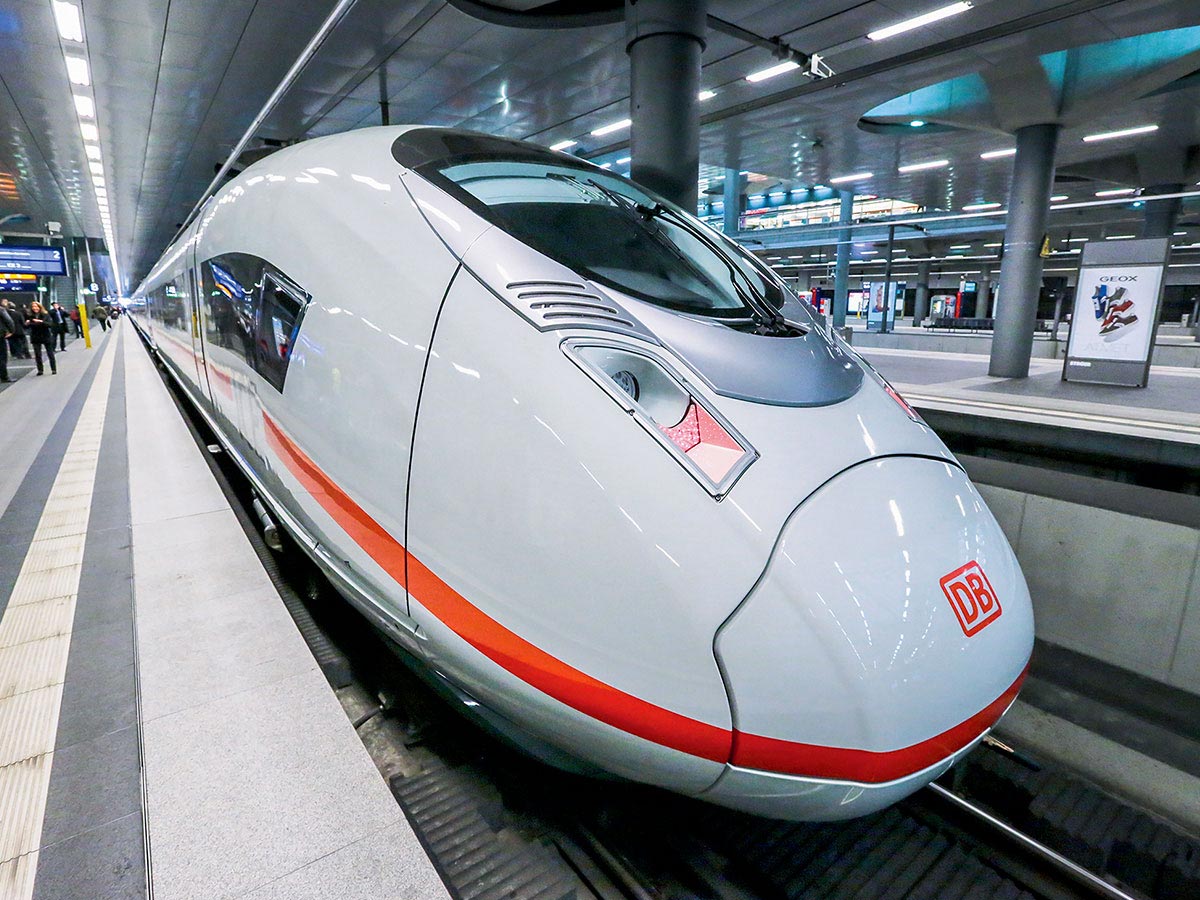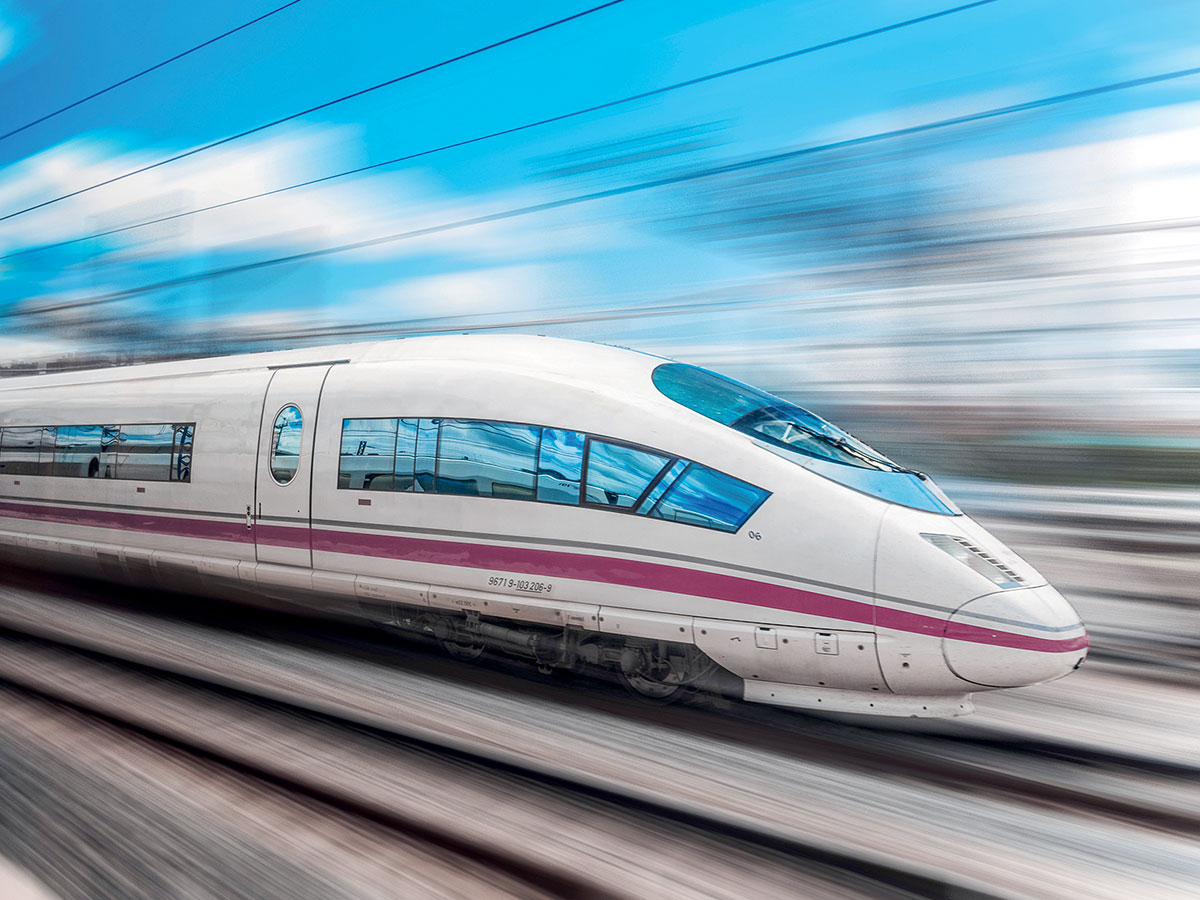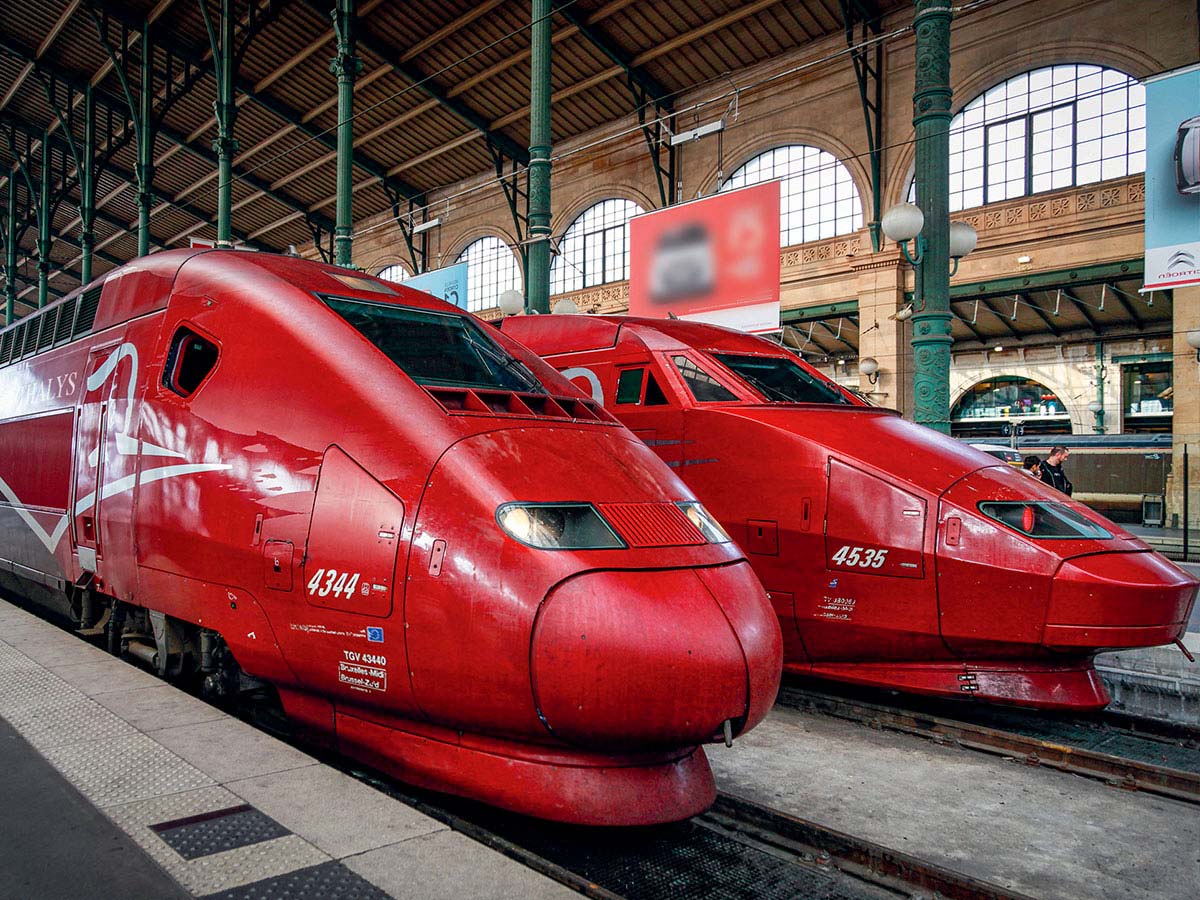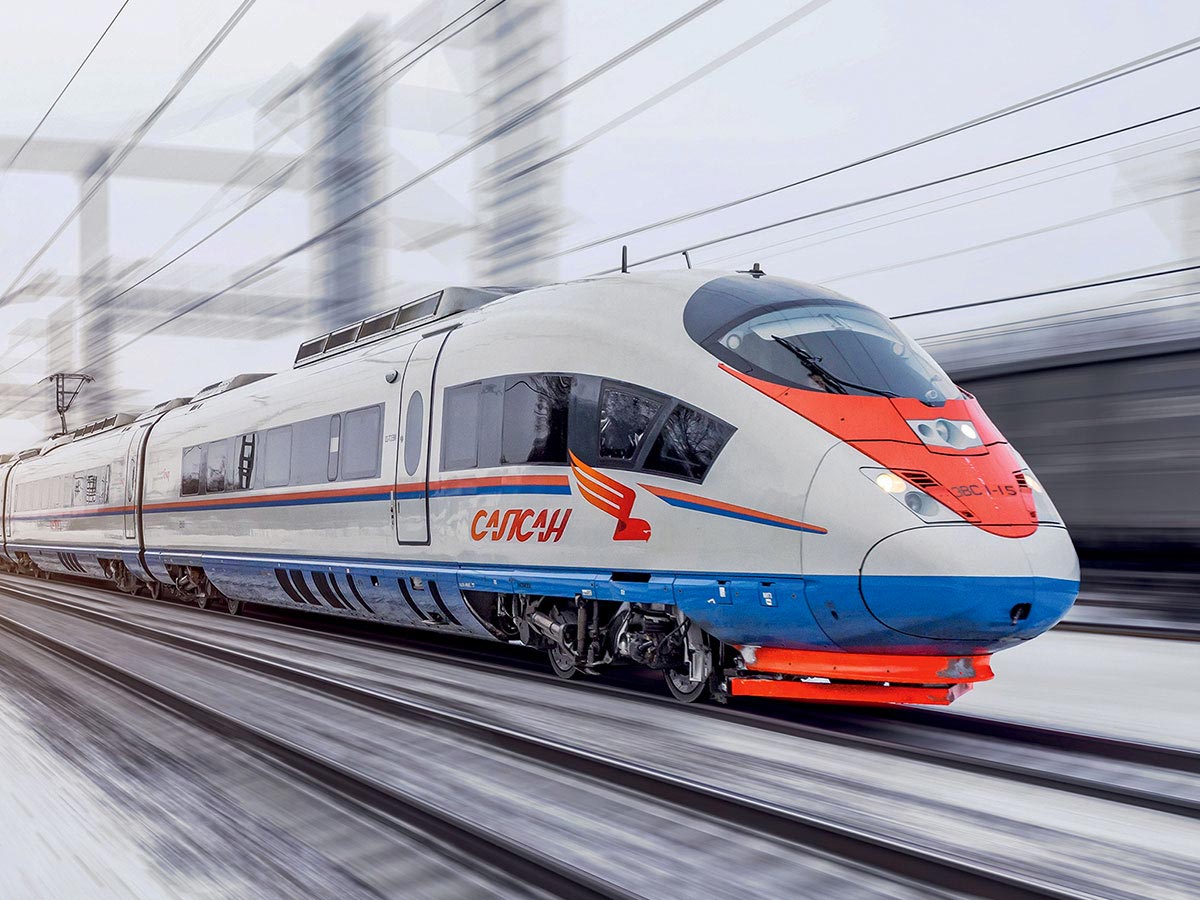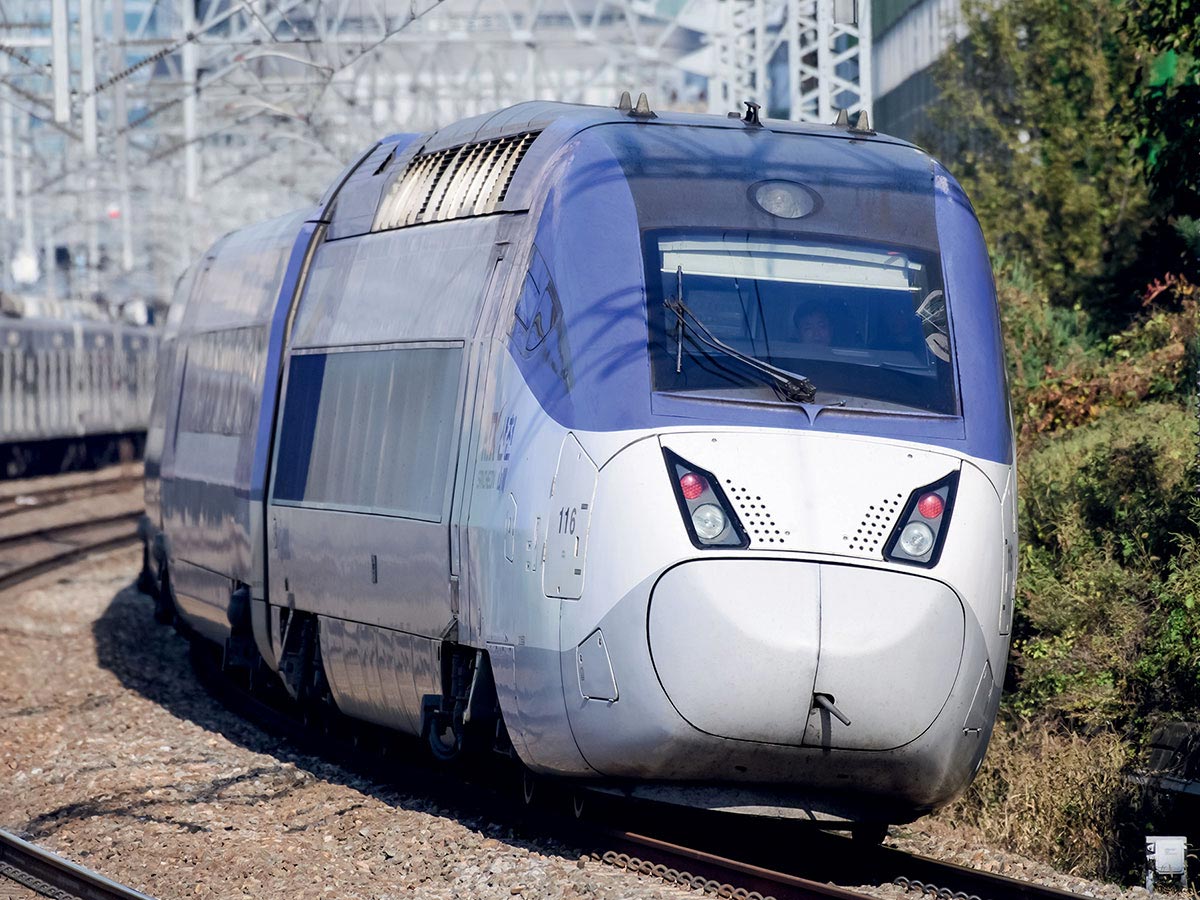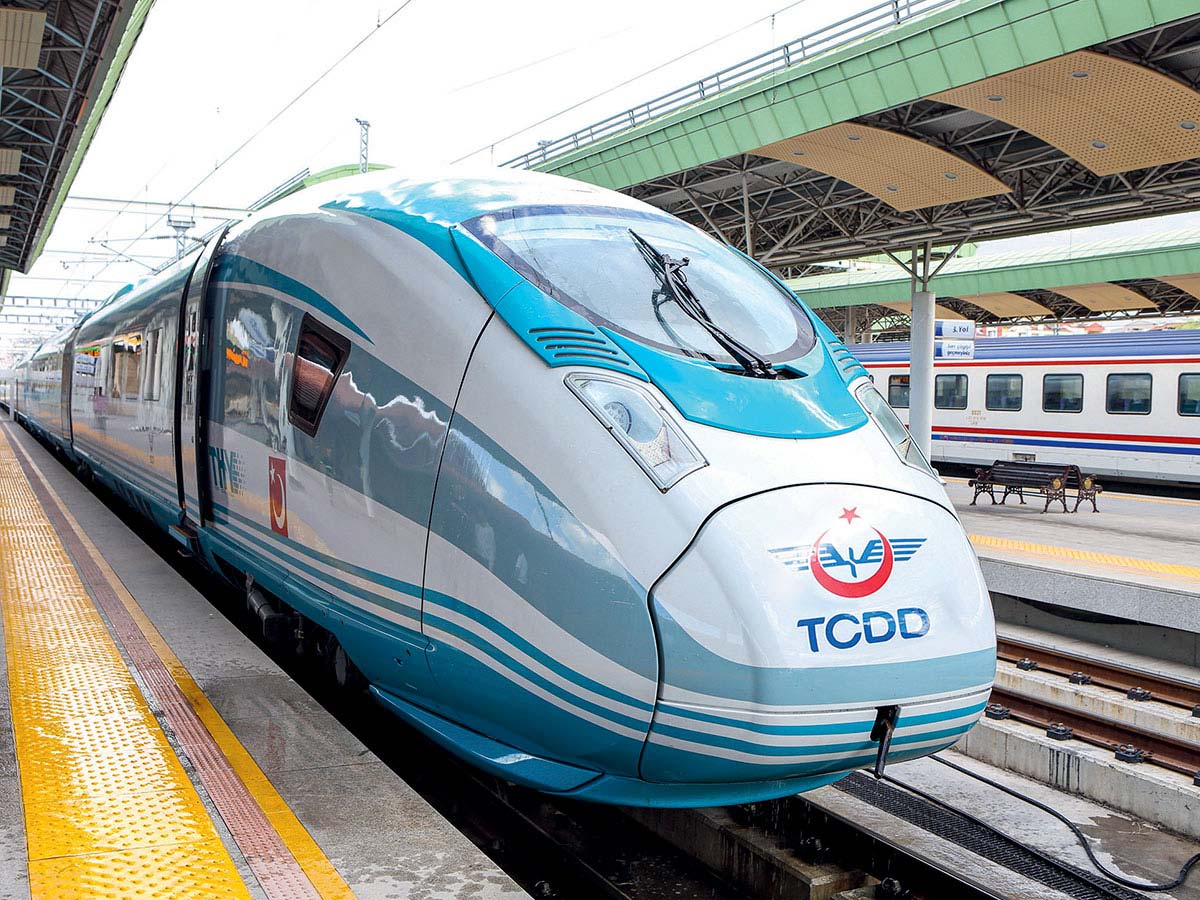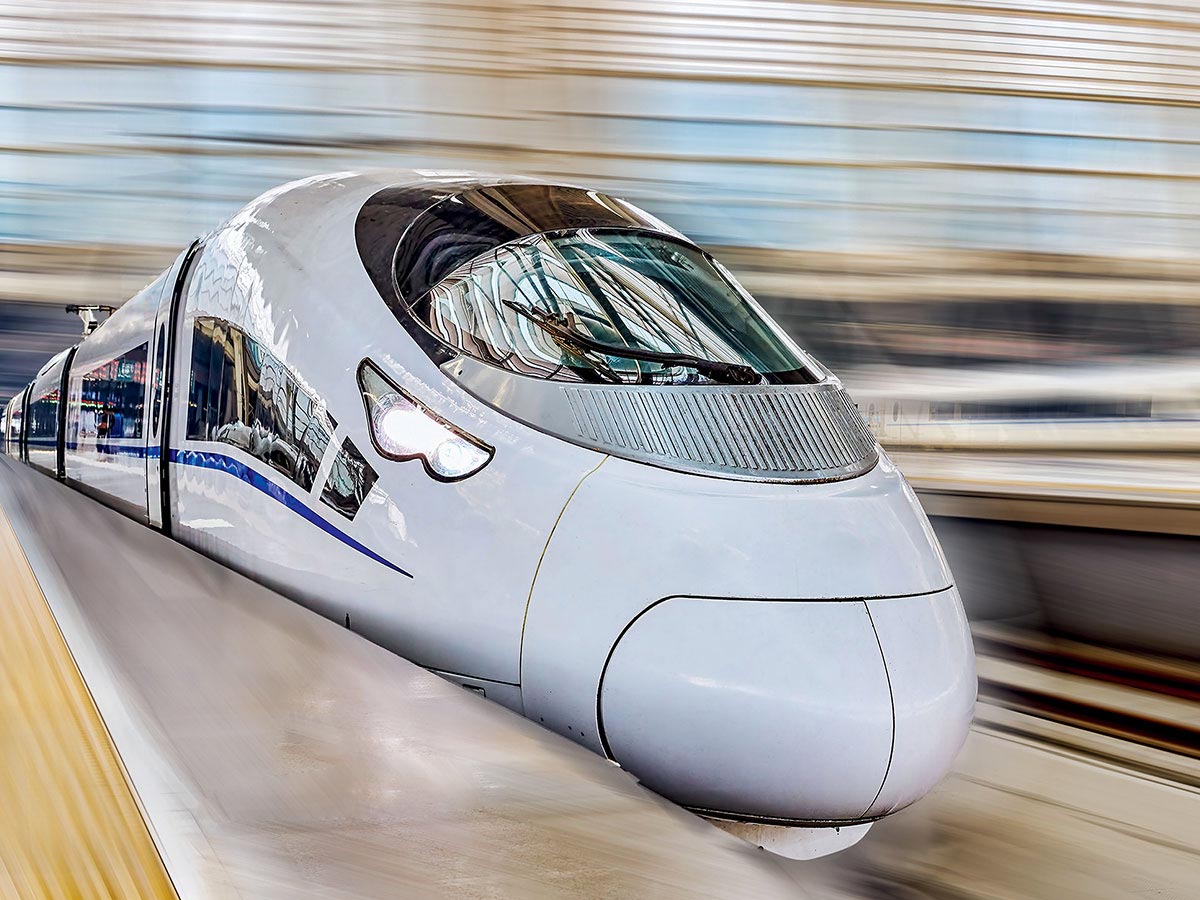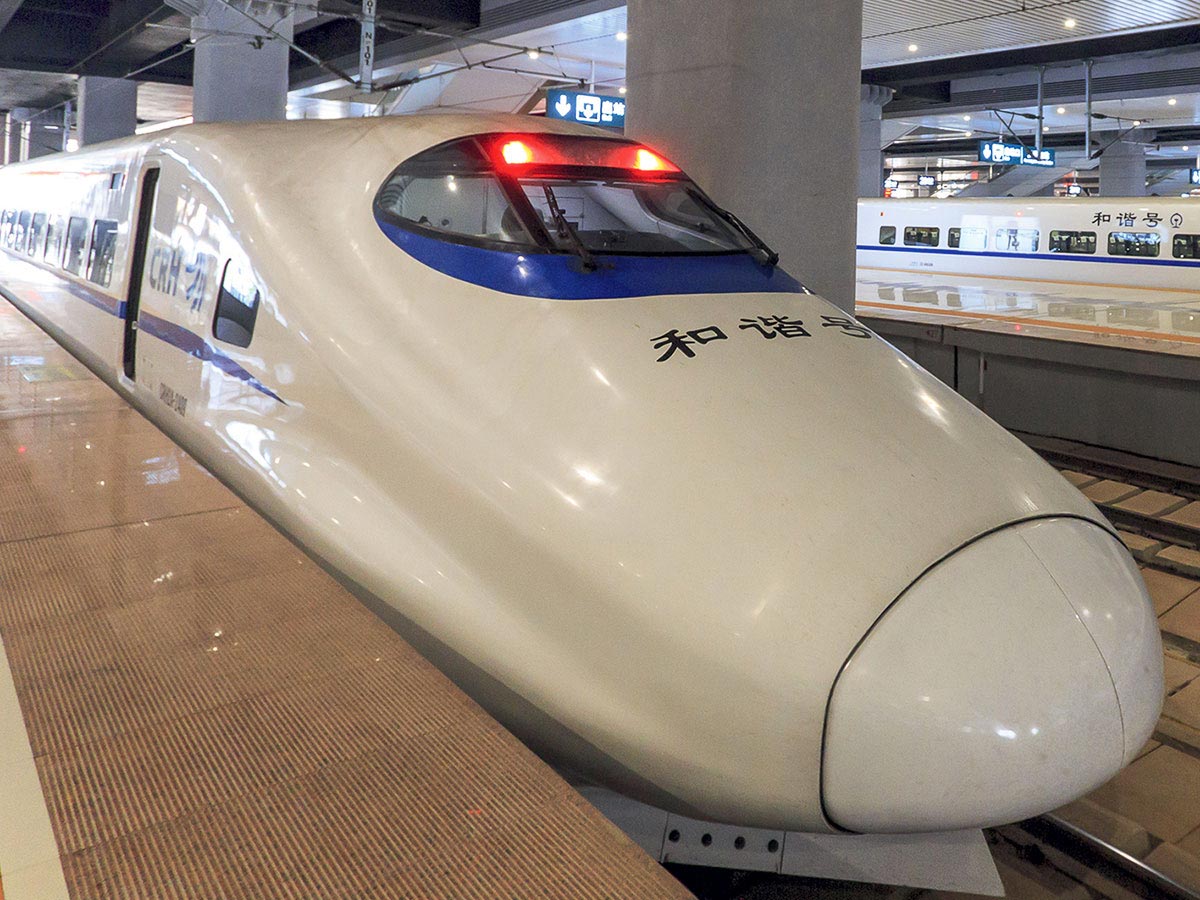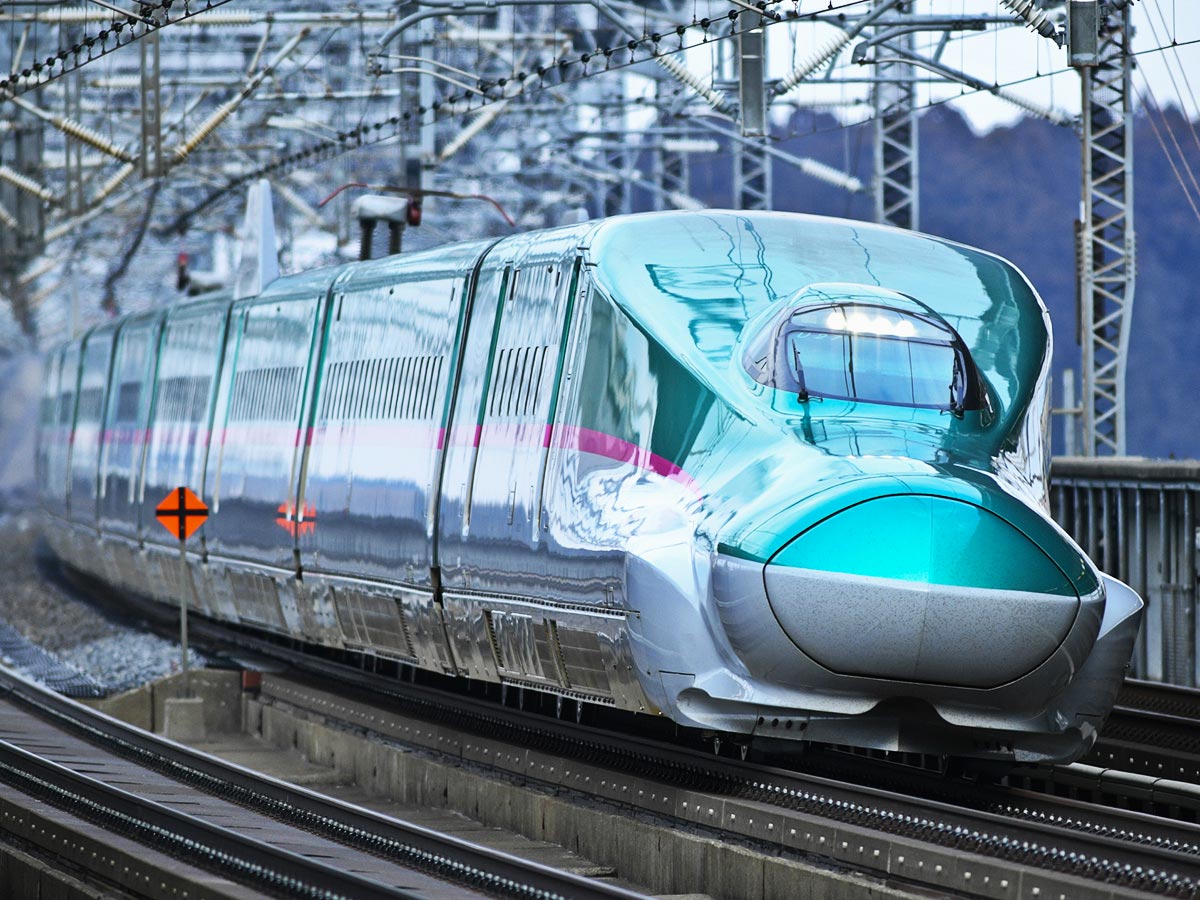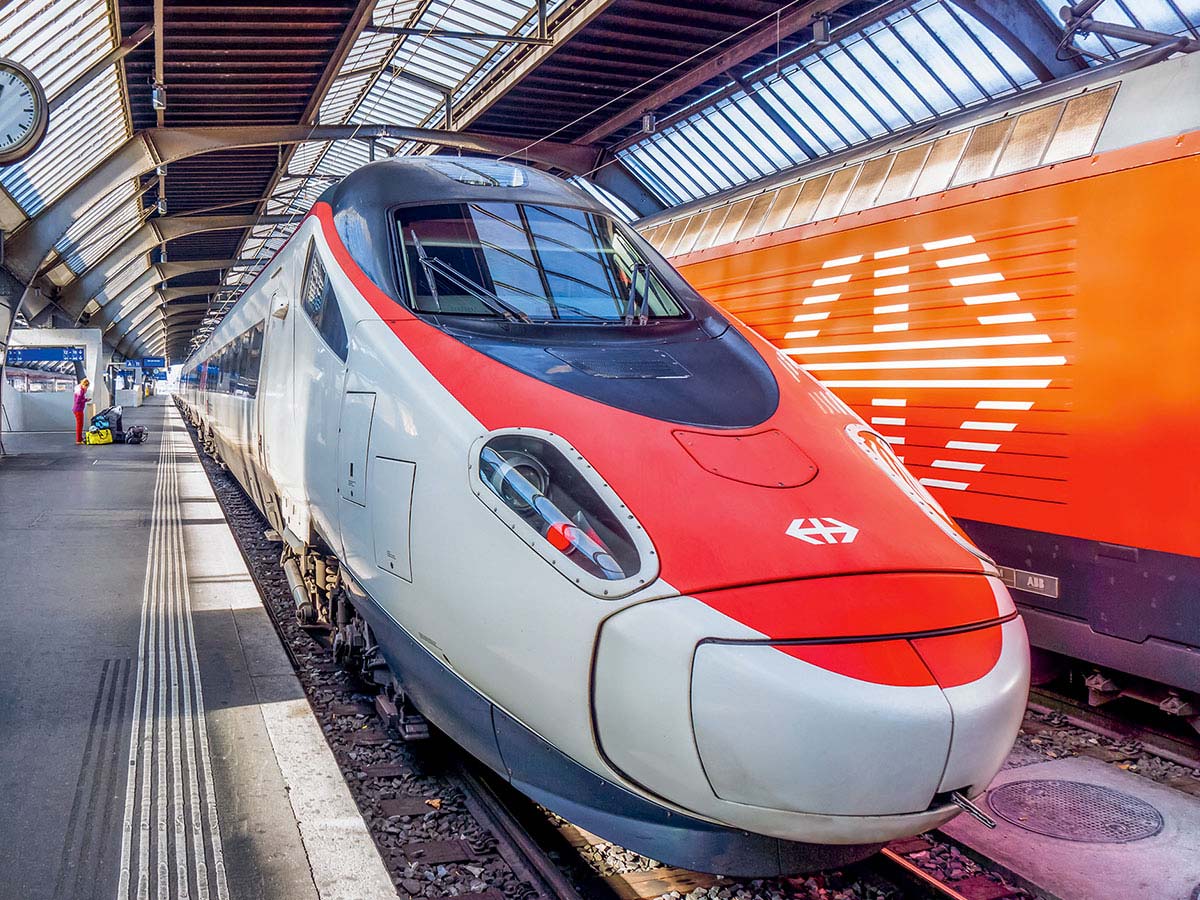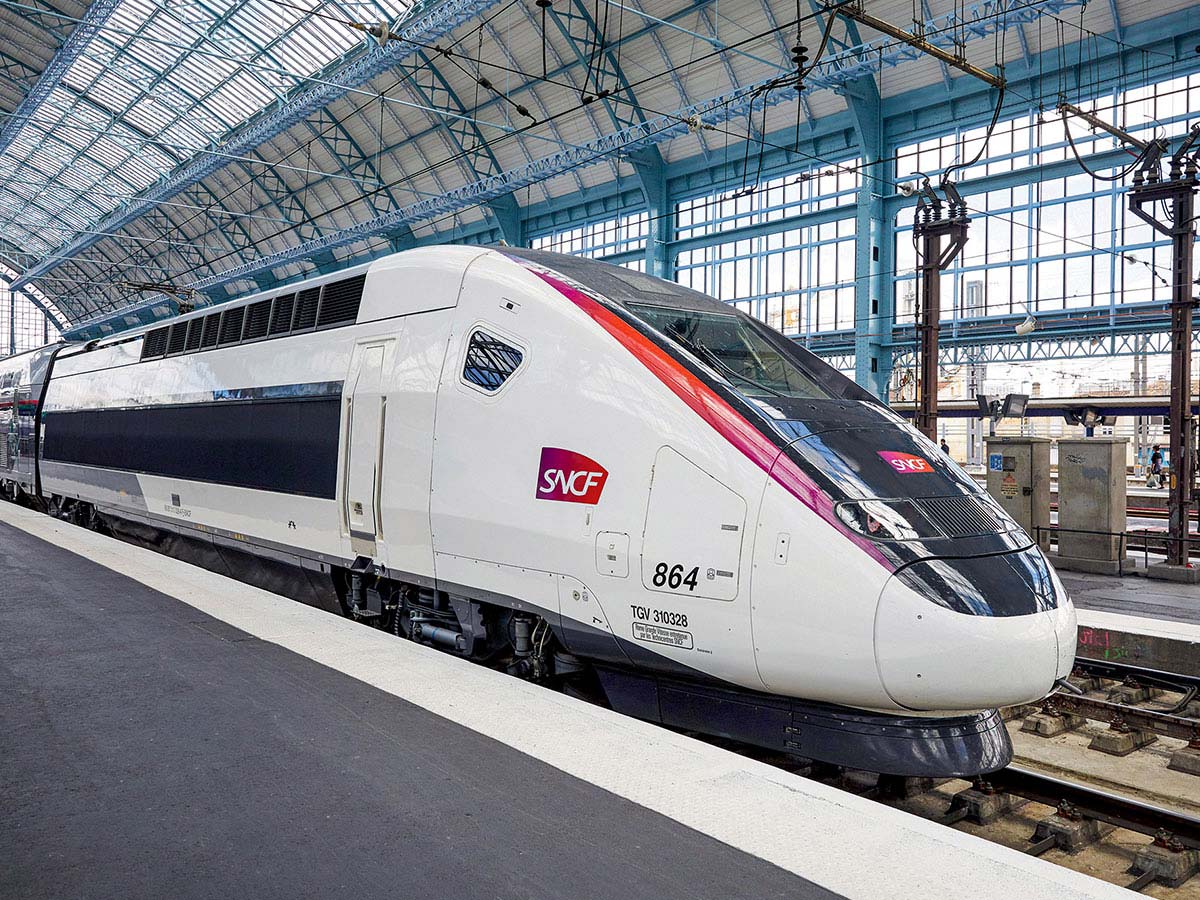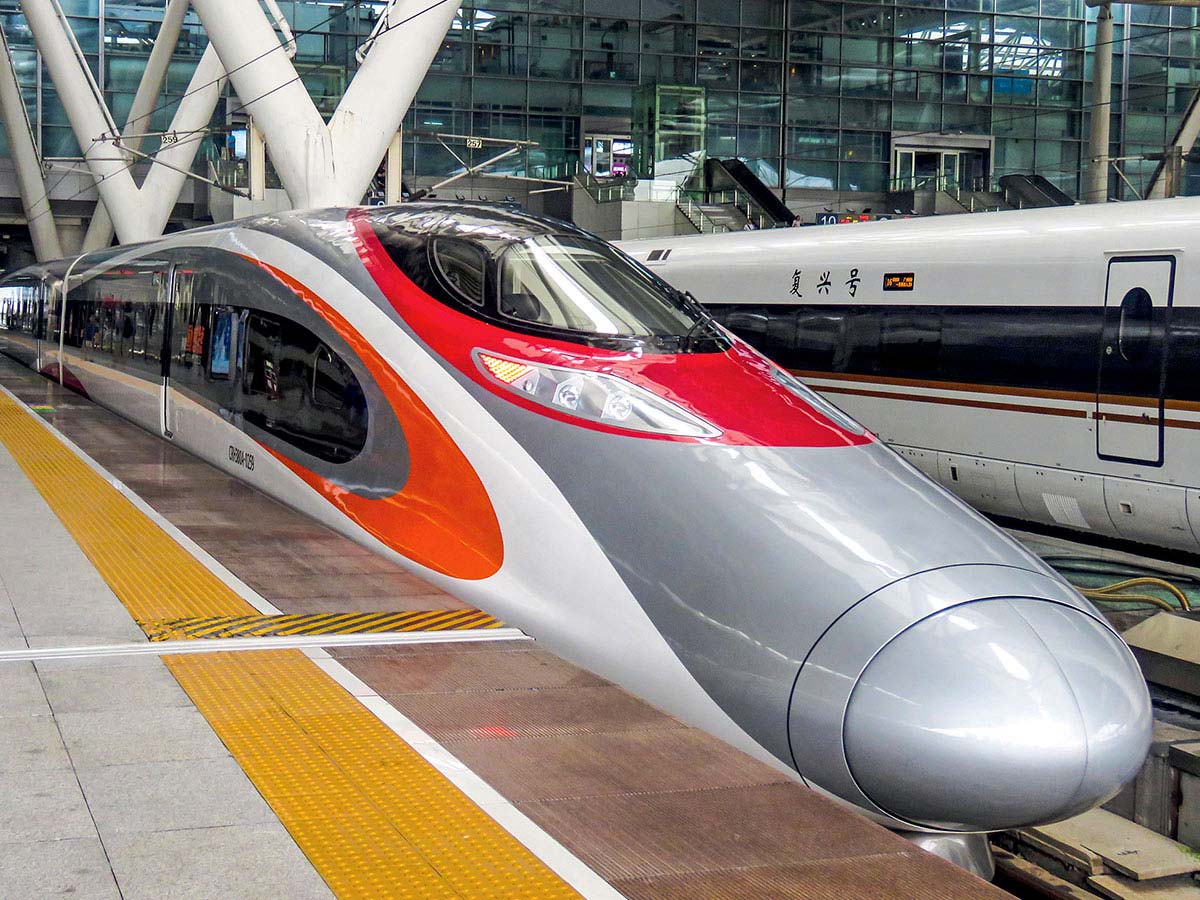BEIJING > HONG KONG

2018 | CHINA
Journey
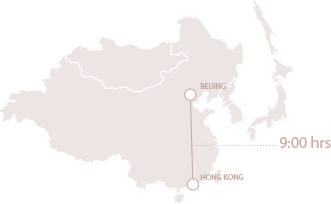
More Info
- Length in km: 2 440 km (in 9 hours instead of 24 hours)
- Name of the train: FUXING HAO
Barely nine hours to cover 2,440 kilometres, such is the challenge of the longest high-speed line in the world, connecting Beijing to Hong Kong. The capital city is now closer to southern China, to Guangzhou, and to Shenzhen, symbol of the country’s economic and technological boom. When the Hong Kong section opened to traffic in 2018, the minimum travel time from Beijing to Hong Kong was cut down to nine hours. Hong Kong, the mecca of finance, has been part of China for twenty-two years, though it has retained its status as a special administrative area. This north-south line serves the immense conurbation of the Pearl River Delta, thus connecting the country’s central regions hitherto overlooked in favour of coastal China.
Leaving Beijing
Profoundly transformed in the 1980s, Beijing underwent another metamorphosis during the organisation of the 2008 summer Olympic Games. For this occasion, the city developed futuristic building projects such as the National Stadium, known as “the bird’s nest” for its rounded steel-laced form, or the National Aquatics Centre, a 'water cube' set into the landscape of Olympic Park. Beijing today has expanded to such an extent that urbanists have created several ring roads around the historic centre to manage traffic circulation. The 7th Ring Road - an immense boulevard that connects many neighbouring cities and provinces– measures 940 kilometres, the equivalent of 300 kilometres diameter if it were a perfect circle! Gigantic suburban areas have emerged around the capital city.
As far as the eye can see, modern towers have replaced the last orchards and farmhouses. Trains bound for Wuhan, Guangzhou and Shenzhen depart from Beijing West Station, situated in the Fengtai district. The station’s monumental archway stands as façade on the wide south esplanade, near the Lotus Pond Park and a few hundred metres from Maliandao Tea Street, the largest tea market in Beijing. On the north side, another esplanade leads to the Millenary Monument, commemorating five thousand years of the history of China. Erected in 2000, this circular structure is capped by a steel needle pointed skyward, symbolising Chinese culture. Temple enthusiasts will also enjoy a visit to the nearby White Cloud Temple, a major Taoist sanctuary.
Construction stages
In 2009, the Wuhan-Guangzhou line was put into service. In 2011, Guangzhou was linked to Shenzhen (102 kilometres) on China’s southern border. With the opening of Beijing-Shijiazhuang and Shijiazhuang-Wuhan sections, the entire Beijing-Shenzhen line was inaugurated on 26 December 2012, the anniversary of the birth of Mao Zedong, founder of the People’s Republic of China. The extension of this line to Hong Kong has been operating since September 2018. In eighteen minutes, travellers can ride from Shenzhen to Kowloon West, the new rail station of Hong Kong. This much-anticipated axis cut the travel time between Beijing and Hong Kong by nearly two-thirds, or nine hours instead of twenty-four, thanks to an average travelling speed of 275 km/h!
Beijing-Hong Kong, the journey
Leaving Beijing, the line heads directly south. First provincial city is Shijiazhuang, capital city of Hebei, an interesting stopover to visit Zhengding, the old fortified city surrounded by four pagodas, and home to a twelve hundred-year-old temple. From Henan’s capital city of Zhengzhou, built along the banks of the Yellow River, or Huang He, it is a short trip to the famous Shaolin monastery, founded in the 5th century. Kung Fu was invented here, and today an international training centre teaches masters from around the world. In addition to a vast temple, the site also features a cluster of stupas, over 200 brick funerary mounds that contain the ashes of Buddhist monks. From Zhengzhou, another high-speed line travels to Xi’an, a city with a fabulous historic heritage. It is here that visitors may admire the army of life-sized terra cotta soldiers, each with its own unique features.
Discovered by accident in 1974, this masterpiece depicting the army of Qin, the first emperor of China, dates back to the 3rd century BC.
Halfway along the line, the train stops at Wuhan, the capital of Hubei Province, one of the great economic centres of the country. It is difficult to perceive at first glance the tangle of buildings and motorway overpasses. And yet, among the many traces of the city’s historic past looms the Yellow Crane Tower, representing the bird that is a symbol of longevity and wisdom, often present in Chinese legends and paintings. Relocated to Snake Hill, this four-storey pagoda is a former watchtower that has been rebuilt many times. The tower’s name is derived from a poem written under the Tang Dynasty in the 8th century, and passed down from generation to generation.
The train then runs through Hunan Province, among the rice paddies of China’s vast food basket region. Changsha cultivates the legacy of Mao, notably as the home of the university where the former Chairman pursued his studies. In the heart of the city, on the Orange Isle in the Xiang River, stands a monumental granite sculpture of young Mao. The train continues on to the left of the sacred hillsides of Heng Shan, a sacred site in Taoism, where thirteen-hundred-year-old temples are set in a luxurious landscape. The line ends in the province of Guangdong, which, thanks to Guangzhou, is one of the most dynamic zones in the country. Located on the north bank of the Pearl River Delta (Zhu Jiang), this immense metropolis is a lively and business-oriented city, known for its temples, marketplace, cuisine, and the gigantic international fair. The Asian Games took place here in 2010, strengthening the city’s transportation options. Not to be missed is the futuristic silhouette of the opera house, designed by Zaha Hadid. Upon departure from Guangzhou, the train drives through an undersea tunnel and Shenzhen to reach Hong Kong in a mere eighteen minutes.
→ Concourse of Beijing West Railway Station.
Major engineering works
The 2,300 kilometres that separate Beijing and Guangzhou were built over a seven-year period section by section; nearly 90% engineering works of the line are bridges and tunnels. Among these is the magnificent bridge that spans the Yangtze River, northeast of Wuhan. 4,657 metres long, the bridge receives both automobile traffic and high-speed rail travelling at 250 km/hr. Below the Pearl River Estuary runs the undersea Shiziyang Tunnel (10.8 kilometres) that connects Guangzhou and Shenzhen. An outstanding performance, as trains can travel through the tunnel at 300 km/hr.
The largest high speed network in the world
The Chinese high-speed network extends across 31provinces – there are 34 overall (including provinces, cities and autonomous regions) – and represents two-thirds of all worldwide high-speed lines operating today. In 2020, 36,000 kilometres will serve 80 % of the country’s metropolises. China was the first country to achieve a commercial speed of 350 km/hr. The network benefits from some 3,000 high-speed trainsets (CHR), or over half of the world’s entire fleet.
On-board and station services
In general, Chinese rail stations share the same dimensions as airports, and are conceived with the same standards of security: X-rays of all checked baggage and passengers under a walk-through metal detector, departure lounges, security controls. Identity papers are required to obtain entry into the rail stations. For security and logistic purposes, there is no direct access to platforms, which thus remain free of congestion. Passengers reach the platforms to board trains only a few moments before they arrive. These rail stations are relatively calm in off-season times, but during the most important holidays such as Chinese New Year, crowds fill the halls. In certain waiting areas, agents ensure that passengers remain seated in order to keep passageways clear.
The rail agents – mostly women – are in uniform, with tailored suits in blue - or red - and white. They stand in front of the train along its full length to welcome passengers. In order to facilitate movement on-board, the rail cars are all connected. Passengers enjoy an excellent WiFi connection, a restaurant car in the middle of the train and a mobile service that offers drinks, fruit, and snacks. Free hot water dispensers are located at each end of all cars. Passengers with reduced mobility are welcomed with a variety of facilities. The CRH trains offer four categories of service: 1st and 2nd class, a superior class – on selected high-speed trains – and a business class. This last option proposes quality service, and offers three seats per row rather than four, and offer lie-flat fully-reclining seats oriented in the direction of motion.
→ A CHR in the station at Hong Kong-West Kowloon.
Last stop: Shenzhen
In 1980, after being transformed into a “special economic zone” granted with a legal system that makes it attractive to foreign investment, the modest town of Shenzhen became one of the most prosperous cities of China. Skyscrapers in surprising shapes rise up against the backdrop of the South China Sea, beyond the major port and popular beaches. The city is known for its theme parks: Splendid China recreates the great monuments of Chinese history in miniature, such as the Great Wall or the terra cotta soldiers of Emperor Qin; Window of the World presents miniature – yet sizeable - versions of the great attractions of the world: the Eiffel Tower, Buckingham Palace, Machu Picchu, the Taj Mahal.
The CRH trains enter the Shenzhen North station, then the Futian Railway Station in the southern part of the city. Open to the public in 2015, this three-level underground station is of impressive dimensions.
Arriving at Hong Kong
As of September 2018, the high-speed train connects Shenzhen to West Kowloon Station, an ultramodern five-storey structure where visitors can view the sunset over the bay of Victoria Harbour. Monitoring of departures and arrivals between continental China and Hong Kong takes place in the station. As the ultimate futurist city, Hong Kong has laid claim to a unique identity. Two official languages – Chinese and English –as well as proper political, legal, and administrative systems that confirm the saying: “One country, two systems”. The northern coast of the mountainous island of Hong Kong is home to Central, the financial district, and its brilliant skyscrapers are reflected in the waters of Victoria Harbour. A cable car climbs to the top of Peak Victoria, offering a stunning panorama of the islands and the tops of high rise buildings. On the other side of the bay, Kowloon is crossed by Nathan Road, a shopping high street that is lively by day and brightly lit at night by huge neon signs. On each side are a variety of neighbourhoods. Here are two of the city’s great museums of art and history, as well as a flower market and very established bird market. Around the islands of Hong Kong and Kowloon, two hundred and sixty islands make up the new territories, which represent 80% of the city.
An industrial policy
The important investments awarded by the Chinese state for development of a rail network allow industrial concerns to build up a backlog of orders for years to come. Thanks to the size of the internal market and to a large and qualified workforce, businesses – for the most part public – have been successful in the development of innovative technologies.
Today, these strengths allow them to export technical knowledge, currently to Africa, and gradually to Southeast Asia, Europe and the rest of the world.
The impact of the north-south axis
Rapidity, security, comfort: since it was first launched, the high-speed train has proved to be very popular. This north-south line has spectacularly reduced the travel time between Beijing and Hong Kong and transformed economic life by facilitating journeys over long distances. Hong Kong is no longer an isolated island, though it resolutely holds on to its particularity.
Forced into competition by high-speed rail, airline companies have begun to offer new discount rates. Cities located along this rail axis have attracted new investors and companies located elsewhere before the line was built. Wuhan, at the heart of the high-speed network, continues its path to expansion as a headquarters to many corporations, and a major hub for the automobile industry.
a selection of HIGH-SPEED LINES by creation date
1964

TOKYO > OSAKA
1992

TURIN > NAPLES
1992

MADRID > SEVILLE
2002

COLOGNE > FRANKFURT
2008

BARCELONA > MADRID
2010

SEOUL > BUSAN
2011

BEIJING > SHANGHAI
2014

ANKARA > ISTANBUL
2014

LANZHOU > URUMQI
2016

SHANGHAI > KUNMING
2016

TOKYO > HAKODATE
2016


ZURICH > MILAN
2018

BEIJING > HONG KONG
2018

TANGIER > CASABLANCA


